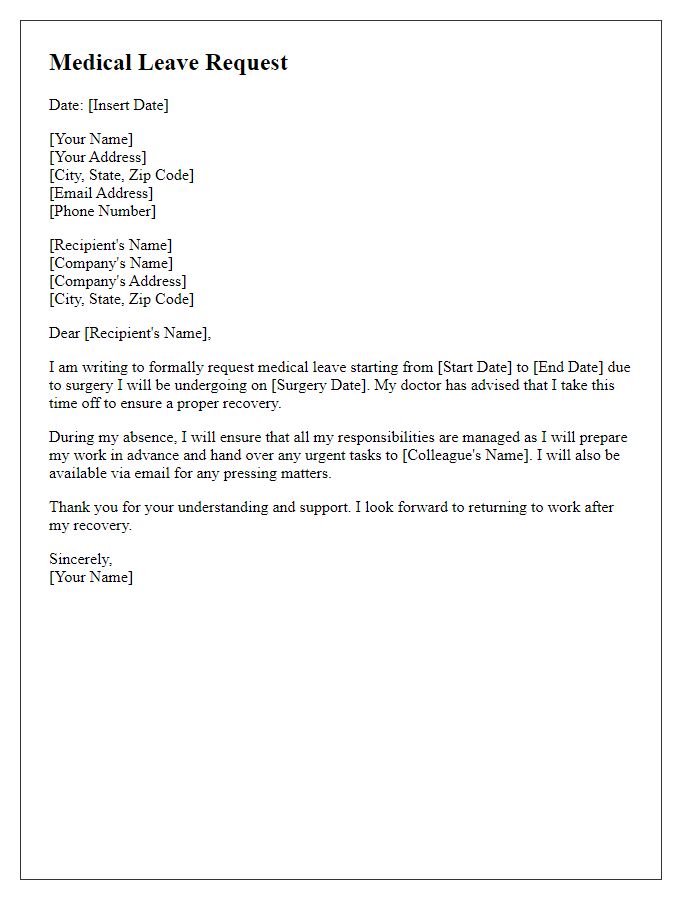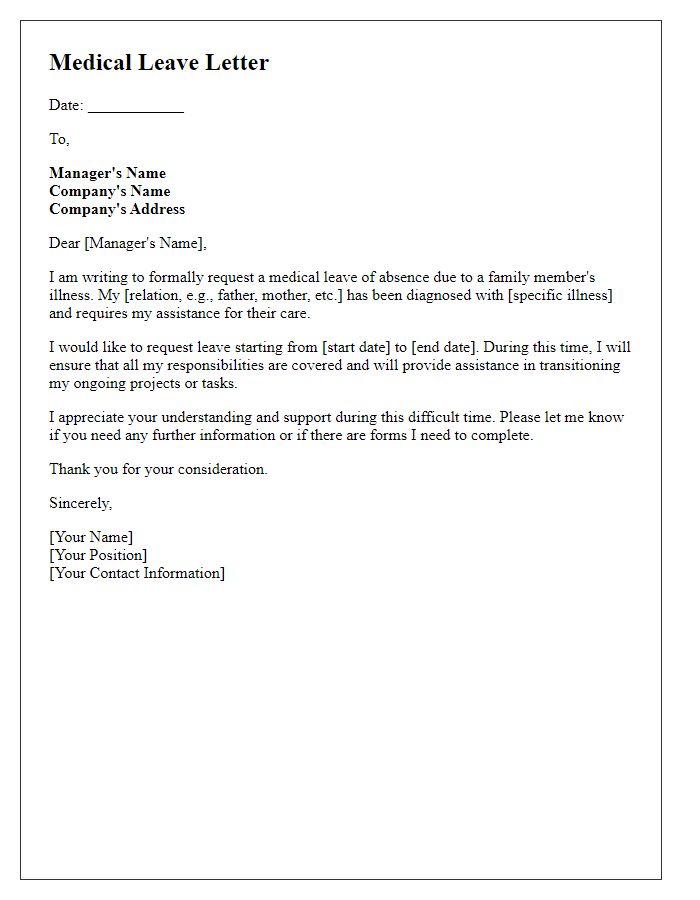Taking a break from work due to medical reasons can be challenging, but having the right documentation can make the process smoother. In this article, we'll explore an effective letter template for requesting medical leave, ensuring you communicate your needs clearly and professionally. Whether it's for a surgery, recovery, or any health-related issue, knowing how to format your request can alleviate some stress. So, let's dive in and get you prepared to write that crucial letter!

Patient's Full Name and Contact Information
Patient's full name, including first, middle, and last name, is crucial for accurate medical records and correspondence. Contact information should include a personal phone number, ideally a mobile number for quick communication, and an email address for formal documentation. This information ensures that healthcare providers can reach the patient for follow-ups or clarifications regarding their medical condition and treatment plan. Proper identification aids in the seamless processing of medical leave requests and insurance claims, facilitating better patient care and administrative efficiency.
Doctor's Full Name, Credentials, and Contact Information
Submitting medical leave documentation requires precise details to ensure compliance with workplace policies. A doctor's credentials, like MD (Doctor of Medicine) or DO (Doctor of Osteopathy), provide assurance of their expertise. Their contact information, including phone number and office address, allows employers to verify the authenticity of the document if necessary. Clarity on the patient's condition, duration of leave, and specific dates for absence, such as from January 10 to January 24, 2024, is essential. This information supports a smooth approval process for both the employee's needs and the employer's policies regarding medical absences.
Detailed Medical Diagnosis and Treatment Plan
A detailed medical diagnosis and treatment plan often includes information regarding specific health conditions and prescribed interventions. For instance, a diagnosis might involve chronic migraines, characterized by recurring severe headache attacks, often accompanied by nausea and sensitivity to light. Treatment plans may encompass medications like triptans, non-steroidal anti-inflammatory drugs (NSAIDs), and preventive treatments such as beta-blockers or lifestyle modifications. Regular consultations with healthcare professionals, including neurologists or primary care physicians, play a vital role in managing these conditions effectively. Additionally, complementary therapies such as cognitive behavioral therapy or acupuncture may be considered to support overall well-being. Accurate documentation of these elements ensures clear communication among healthcare providers and facilitates appropriate medical leave from professional responsibilities.
Inclusive Dates of Required Medical Leave
Medical leave documentation often requires specific details for accuracy and clarity. The inclusive dates of required medical leave typically indicate the beginning and end of a medical absence from work. This documentation may outline critical information, such as the start date, which could be a specific day in March 2023, and the end date, potentially ranging until early April 2023. It is essential to include a healthcare provider's recommendation, detailing the diagnosis or condition necessitating the leave, for instance, recovery from surgery or treatment for a chronic illness. Furthermore, any required follow-up appointments or ongoing care might also be noted, ensuring the employer understands the necessity and duration of the leave.
Confirmation of Follow-up Appointments or Required Care
The confirmation of follow-up appointments is crucial for maintaining optimal health during recovery, particularly after medical procedures such as surgeries or invasive treatments. Scheduled appointments at local hospitals, such as Springfield Medical Center or downtown City Hospital, often occur within one to three weeks post-treatment as recommended by healthcare providers. These appointments might include consultations with specialists, such as orthopedic surgeons or physiotherapists, to ensure proper healing and management of any side effects. Additionally, required care may involve ongoing therapies, such as physical rehabilitation, typically advised at least twice a week, depending on the severity of the condition. Maintaining a comprehensive record of these appointments and any prescribed medications serves to monitor recovery progress and avoid complications in the healing process.













Comments